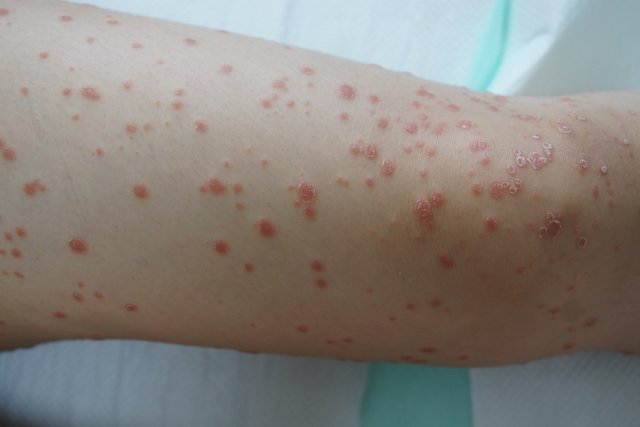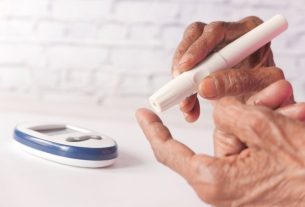Guttate psoriasis is a type of psoriasis that can develop after upper respiratory tract infections, such as tonsillitis or sinusitis, caused by bacteria of the genus Streptococcusleading to the emergence of symptoms, such as small and numerous red tear-shaped or circular lesions on the skin all over the body, itching or peeling of the skin.
The symptoms of guttate psoriasis usually appear about one to three weeks after infection, being more common in children, adolescents or young adults, and despite being triggered after bacterial infections, guttate psoriasis is not contagious.
The treatment of guttate psoriasis is carried out by a dermatologist, who may recommend the use of ointments, creams, lotions or shampoos containing corticosteroids, retinoids or vitamin D analogues, or in some cases, phototherapy.
Sensitive content
This image may contain content that is uncomfortable for some people.

Symptoms of gutta psoriasis
The main symptoms of guttate psoriasis are:
- Red teardrop-shaped or circular lesions on the skin;
- Small blisters or plaques measuring 2 to 6 mm, spread across the body;
- Lesions covered by a fine scale;
- Injuries in areas of trauma, known as Koebner phenomenon;
- Itching at the site of the injury;
- Peeling of the skin in the area of the lesion;
Symptoms of guttate psoriasis may appear more frequently on the arms, legs, scalp or trunk. These lesions can appear from one moment to the next and can be prominent, starting small and increasing in size and quantity over time.
It is important to consult a dermatologist whenever symptoms of guttate psoriasis appear, so that the diagnosis can be made and the most appropriate treatment can be initiated.
How to confirm the diagnosis
The diagnosis of guttate psoriasis is made by a dermatologist through the evaluation of skin lesions, health history and recent infections, and the use of medications that inhibit TNF-alpha, beta blockers or antimalarials, for example.
Although evaluating the lesions is sufficient to confirm the diagnosis, the doctor may also request blood tests, such as antistreptolysin O (ASLO), anti-DNase B or streptozyme, which allow checking for a recent infection by Streptococcusand thus confirm the diagnosis.
Generally, a skin biopsy is not necessary, however, in some cases, the doctor may request it to differentiate from other diseases, such as Tinea corporis, nummular eczema or ptyriasis rosea, and confirm the type of psoriasis. See the main types of psoriasis.
Possible causes
The main cause of guttate psoriasis is a bacterial infection, mainly by bacteria belonging to the genus Streptococcusin which symptoms typically appear about one to three weeks after an upper respiratory tract infection, such as tonsillitis or sinusitis, for example.
Some factors may contribute to increasing the risk of developing guttate psoriasis, such as:
- Stress;
- Use of TNF-alpha inhibitor medications, such as infliximab, etanercept or adalimumab;
- Use of beta-blocking or antimalarial medications;
- Genetic changes;
- Family history of chronic psoriasis, especially first-degree relatives;
- Rheumatoid arthritis;
- Skin injuries caused by cuts, burns or insect bites,
- Other inflammatory and infectious processes.
Generally, guttate psoriasis can appear in people who have one or more risk factors, and it is important to consult a dermatologist whenever symptoms appear so that it can be diagnosed and the most appropriate treatment can be started.
How the treatment is carried out
Milder cases of guttate psoriasis generally do not require specific treatment, as the symptoms of the disease usually disappear on their own. However, the dermatologist may recommend the use of moisturizers to alleviate the symptoms of itching and peeling skin.
In moderate to severe cases, the doctor may recommend the use of topical corticosteroids, in the form of creams, ointments or shampoos, vitamin D analogues, such as calcipotriol ointment or gel, or phototherapy with UVB radiation, for example, with the aim of relieving symptoms.
Check out some tips for treating psoriasis in the following video:
Bibliography
- SALEH, D.; TANNER, L. S. IN: STATPEARLS (INTERNET). TREASURE ISLAND (FL): STATPEARLS PUBLISHING. Guttate Psoriasis. 2022. Available at: <https://www.ncbi.nlm.nih.gov/books/NBK482498/>. Accessed on Nov 9, 2022
- FANG, R.; SUN, Q. Guttate Psoriasis. Indian Pediatr. 57. 6; 596-597, 2020
- PFNGSTLER, LF; et al. Guttate psoriasis outcomes. Skin. 97. 2; 140-4, 2016
- NATIONAL PSORIASIS FOUNDATION. Guttate Psoriasis. Available at: <https://www.psoriasis.org/about-psoriasis/types/guttate>. Accessed on October 29, 2019

Sign up for our newsletter and stay up to date with exclusive news
that can transform your routine!
Warning: Undefined array key "title" in /home/storelat/public_html/wp-content/plugins/link-whisper-premium/templates/frontend/related-posts.php on line 12
Warning: Undefined array key "title_tag" in /home/storelat/public_html/wp-content/plugins/link-whisper-premium/templates/frontend/related-posts.php on line 13





